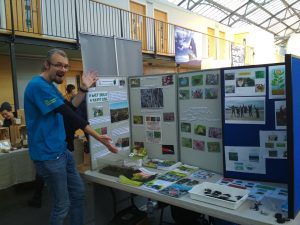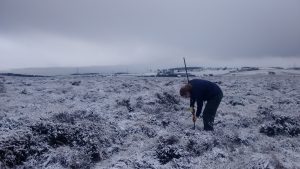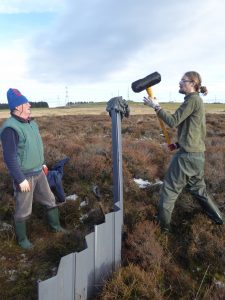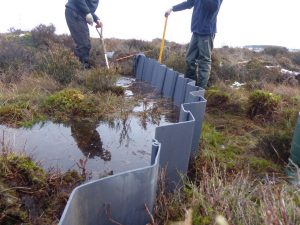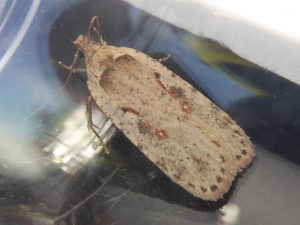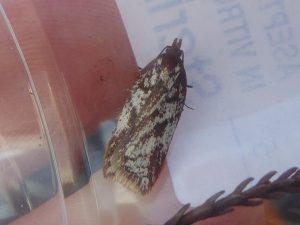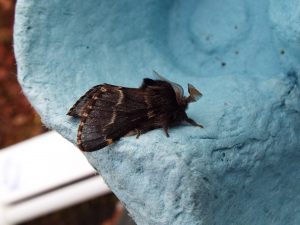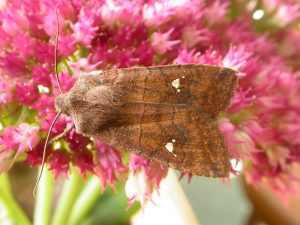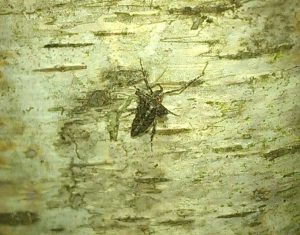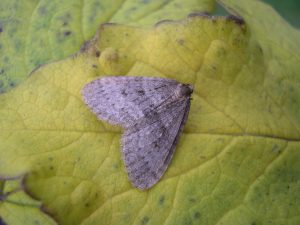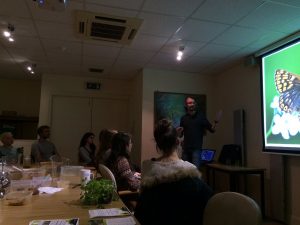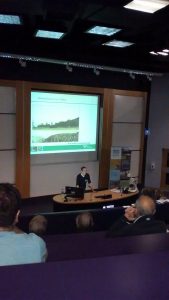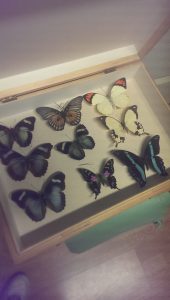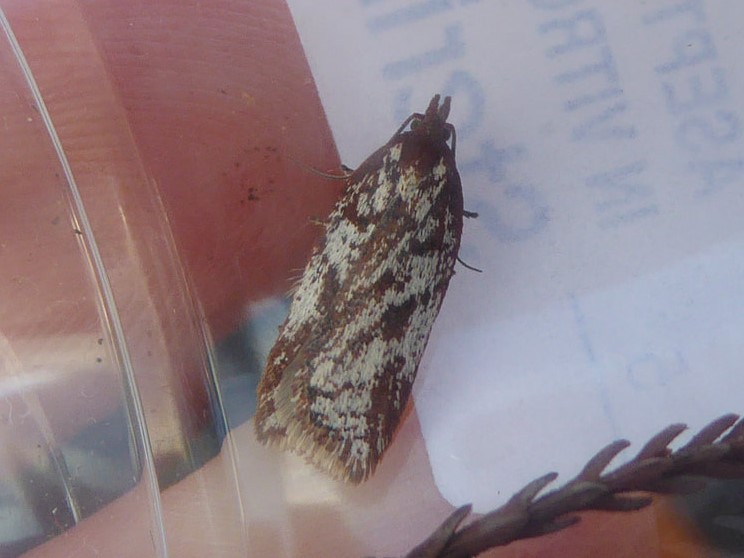
With the autumn changing into winter, and all the trees bare, the moth season has well and truly wound down. Though to my surprise there have still been a micro or two to keep me happy. These last two months turned out to be quite busy despite the lack of moths! Attending lots of public events and participating in the practical conservation is enough to keep me warm in these cold winter days!
November got off to a great start! I attended Greenpeace’s EcoFair in Edinburgh with fellow trainee Aroa. We showcased our projects and promoted TCV to the hundreds of passers-by. It was great to see people asking questions and getting hands on with Aroa’s Seaweeds (and I learnt a bit myself!) And of course there a moth or two on show! Overall, a wonderful day shouting about Natural Talent.
Throughout November I’ve been assisting my mentor at Sergeantlaw Moss, near Paisley. We spent a day out assessing the depth of the peat at different locations. Unfortunately, we were caught in a bit of a snow storm, which hampered our work a little bit! But we layered up and made do!
The following couple of weekends we returned with volunteers as Butterfly Conservation’s Bog Squad to carry out some restoration work. The work we carried out was with the aim to re-wet the bog and promote peat-forming Sphagnum mosses. This involved clearing Birch scrub from the moss and installing dams in the run off channels. These measures will increase the water holding sphagnums and therefore the increase the overall water holding potential of the bog; which has the added benefit of preventing localised flooding nearby.
During the work, we managed to spot a moth or two! These micros we saw were disturbed from the moss. Most likely they were very disgruntled as we’d awoken them from their winter slumber! Some micro moths, (including these found at Sergeantlaw Moss), overwinter as Adults. Meaning these species can be seen in late autumn and early spring.
Agonopterix ocellana, came as a nice surprise whilst hammering in the dams! Many species of this genus overwinter as adults. In the springtime their tatty condition can often give identification headaches! However, in late autumn and early winter, their scales can be fresh and distinct. This lovely A. ocellana feeds on willows and can often be found when disturbing vegetation in damp situations.
Acleris hyemana is very common sight on Peatland bogs. It feeds on heather which is abundant on peatland bogs. This micro has some significance to me, as it was the very first micro that I saw and identified back in April! So in my time as a trainee the young of those moths back in April, will have hatched, feed themselves up make fat little caterpillars, pupated and now be flying around in search of mates; perfectly showcasing the natural cycle of life; the passing of a generation and with the following season, the rise of the next.
Unfortunately these were the only micro moths I had any success in finding over the last two months. Once a month I visited Wester Moss to set light traps, sugar for moths and search for micro moth larva. For micros my search was in vain, however I did manage to find 6 new species for the macro moth list for the SSSI (Site of Special Scientific Interest)! These included the fuzzy December Moth, which can fly in temperatures as low as 2°C. And the Satellite Moth, named after its distinct “Sputnick” like pattern.
The closest thing I got to a micro moth was this Female Winter Moth. Despite her odd appearance she is indeed a moth! Many different species of moth have flightless females, which focus on releasing a pheromone to bring all the male moths to them! They still have wings, but they are only small vestigial structures; not much use for flying.
So despite the cold snap, I’ve found more moths than I had been expecting.
Over the last two months I have had the pleasure of attending a variety of different public events and attending highly informative conferences. With fellow trainee Kirsty and Rosie Walker from TCV, we gave a talk to the Stirling University’s Green-Blue society, talking about TCV, they work they do and our Natural Talent Projects.
I’ve held stalls and attended the Forth Natural History (FNH) conference and The Wildlife Recording centre (TWIC) conference. Both were great opportunities to network and meet with other organisations and to hear about their environmental conservation work and the recording projects they are in involved in.
I have also begun work on a mammoth task; Curating my micro moth collection. Collecting insects has been a pastime for many years, but for entomology it is really important. Some taxa, including some micro moths, are incredibly difficult to identify and one needs to refer to collected specimens for reference, to determine an accurate identification. Keeping a physical record is also incredibly useful as it acts like a time capsule. It allows us to view changes in morphology and distribution of a species over a long period of time. Cutting edge research is still carried out today using animal specimens from the Victorian era! Many museums have thousands of pinned Lepidopteran for these reasons. I am currently embarking on the long and difficult process of learning to how to pin specimens, in this manner. This is an incredibly difficult skill, which will take years to master, but it’s a vital skill that is being lost. I wish to learn how to do this, as many are not learning this skill anymore, but I want to make my own reference collection. One of the issues with micro moth is that their small size often makes it difficult to engage with people. In addition to beginning my own reference collection, my aim by the end of the traineeship was to create a small collection of pinned specimens, to showcase these remarkable animals to the public.
And finally, I’ve been working on my project for the New Year. Micro moths are a group of animals which have been historically vastly overlooked. Macro moth species records can often date back over a hundred years; however Micros have been extremely under recorded. Next year Butterfly Conservation (BC) is publishing a Macro moth atlas gathered from data from the National Moth Recording Scheme (NMRS). This scheme has been running for 10 years and is a similar to macro moth schemes run in the past. This has allowed BC to obtain an accurate record of every macro moth species distribution in the UK to a ten kilometre square! This is a fantastic resource which will help monitor and conserve moths for many years. However, Micros were only introduced into this scheme this year (2017) and many moth-ers don’t have the identification skills or desire to record them. Therefore, these taxa are seriously under-recorded and the national data set is not even accurate to a county level.
The aim of my project is to promote micro moth recording among the moth-er, so that a more accurate picture of micro moth species distributions can begin to be ascertained. So in March of next year I will be running “Micro moths for beginner’s workshops”. These workshops are aimed to towards macro recorders and newcomers to micros moths.
I will be running Free workshops in: Edinburgh, Glasgow, Stirling and Inverness. The dates and venues for the workshops are yet to be confirmed, but if you wish to sign up to the mailing list of a workshop, email me at rmcilwrath@butterfly-conservation.org and request which location you are interested in attending.
2018 will certainly prove exciting! I’m looking forward to the new challenges and the final months of my traineeship.

